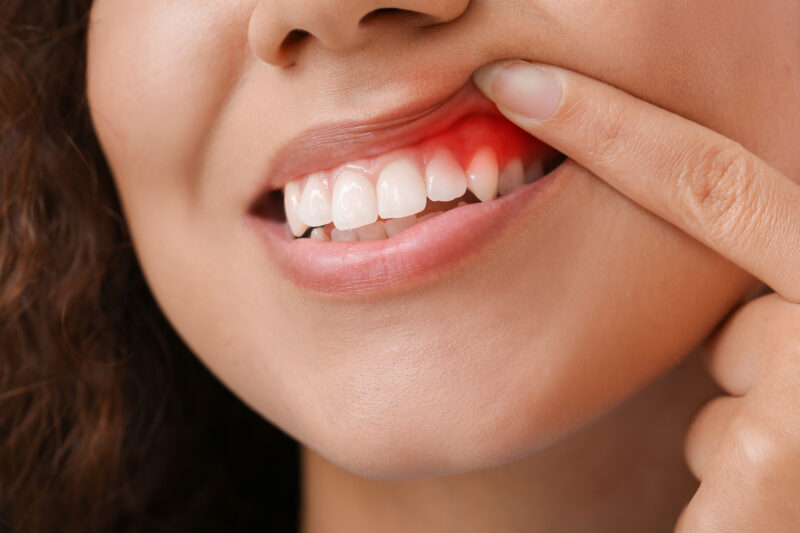
Periodontal disease, or gum disease, is more common than many patients realize. Almost half, or 47.2%, of all adults 30 years old or older have some form of gum disease, and the risk of gum disease increases with age. In fact, 70.1% of adults 65 years old and older have periodontal disease in some form, and this number increases based on additional factors, like smoking or bad oral health habits.
A Bay Area periodontics specialist can help patients identify comfortable and effective periodontics procedures to treat even the most advanced cases of gum disease (like laser therapy for periodontal disease). However, before conducting an internet-wide search for “laser periodontal therapy near me,” it’s helpful to understand the different stages of gum disease. Additionally, it’s good to know what symptoms to look out for and the initiatives you can do now to reverse the problem.
What is Periodontal Disease?
Periodontal disease, or gum disease, is an oral health condition that impacts the tissues surrounding and supporting your teeth. It is caused by a build-up of plaque and bacteria, which form on the teeth and the gums. Periodontal disease can lead to more significant issues like tooth loss without adequate treatment.
What Causes Periodontal Disease?
The primary causes of periodontal disease are poor oral hygiene habits and inadequate or irregular brushing and flossing. However, several other contributing factors can put a patient at higher risk of periodontal disease. These factors include the following:
- Smoking
- Other medical conditions or chronic health issues, like diabetes
- Certain medications, like steroids or contraceptives
- High-stress levels
- Genetic predisposition
- Hormonal changes, such as during pregnancy
While some contributing factors can be curtailed, like smoking or poor oral health habits, some can’t be altered. For example, periodontal disease is more common in men than women, at 56.4% versus 38.4%.
What Are the Types or Stages of Periodontal Disease?
Like many health conditions that tend to progress with time, there are different types or stages of periodontal disease, and treatment will vary based on the present gum disease type.
- Gingivitis – Gingivitis is the most common and mildest form of periodontal disease, characterized by bleeding around the gums and inflammation. If not treated, gingivitis will progress to more severe types of periodontal disease.
- Chronic Periodontitis – When bleeding and inflammation in the gums become frequent and more routine, it is a sign of chronic periodontitis. This also leads to a gradual but progressive destruction of the supporting structures that surround the teeth. In addition, other signs of chronic periodontitis include bad breath, loose teeth, receding gums, and alterations in bite and/or tooth alignment.
- Aggressive Periodontitis – The main difference between aggressive periodontitis and chronic periodontitis is how the gum disease progresses. Aggressive periodontitis develops very quickly and is more common in younger patients who are otherwise perfectly healthy.
- Necrotizing Periodontal Disease – Though rare, necrotizing periodontal disease is a severe form of gum disease that needs to be treated by a specialist immediately. This form of gum disease leads to tissue death, or necrosis, in the gums and bones that support the teeth. Signs of necrotizing periodontal disease include frequent pain, a foul odor in the mouth, difficulty eating or swallowing, swollen lymph nodes, and fever.
How to Reverse Mild Cases of Periodontal Disease
Some mild types of periodontal disease can be treated at home by taking the following actions.
- Brush your teeth twice every day using a soft-bristled toothbrush.
- Floss every day to remove accumulating plaque around the gums, and in hard-to-reach areas.
- Rinse with a special antimicrobial mouthwash to kill bacteria. (There are even over-the-counter mouthwashes designed to reverse early signs of gum disease.)
- Change your diet and eat healthier fruits and vegetables while avoiding sugary foods whenever possible.
- Quit smoking if you smoke frequently.
Keep in mind that the above steps can help reverse and treat mild types of periodontal disease. The best solution is to consult with a periodontist to help determine whether more advanced procedures are necessary to ensure the gum disease doesn’t progress.
What Does a Periodontist Do for Gum Disease?
The first step for anyone who thinks they may have periodontal disease is to consult with an expert who has access to the most advanced and effective treatments available.
A periodontist can assess an individual’s unique oral health needs. Additionally, they can make recommendations ranging from at-home lifestyle changes to advanced treatments to eliminate the progressing issues.
At Pannu Dental Group, we use the most advanced technology available when treating our patients and including periodontal laser treatment. Laser gum treatment is minimally invasive, with limited or no anesthesia required, and reduces the risk of infection while ensuring a patient’s utmost comfort throughout the process. In essence, the laser’s high-energy light beam acts as a sterilizing agent, reducing the likelihood of bacterial infections and relapses. This means that the patient immediately starts to heal after the treatment is complete.
Dr. Sharon Phamduong, our periodontist who performs this procedure and treats all forms of gum disease, is one of the few periodontists in the world who is certified by Millennium Technology for the PerioLase dental laser used in the LANAP procedure. This means that when it comes to finding the best periodontal disease treatments possible, the solutions are waiting close to home.
Where Can I Find a Periodontist Near Me?
If you are concerned about periodontal disease or want to explore your options when it comes to advanced and comfortable treatments, then your first step should be to connect with the professional and caring team at Pannu Dental Group.
From mild forms of gingivitis to the most advanced forms of periodontal disease, we have the technology and expertise to help with all oral health issues in a safely, effectively, and minimally invasively.
We understand that patients can be nervous about spending time in the dentist’s chair, so we strive always to provide a positive and comfortable experience that results in the best oral health possible.
Reach out to us today. Discover how technology and dedicated patient care combine to create the best periodontal disease treatments.
Schedule an appointment today.
Dr. Dalvir S. Pannu has been a practicing dentist since 1995. In 1996 he opened his first dental practice in India, where he gained invaluable experience and acumen. In October of 1997 he was invited by the American Dental Association (ADA) to present the table clinic on Endodontics, at their annual session held in Washington, D.C. At this time he fell in love with the United States and became passionate about practicing dentistry in California. He became particularly enamored of the San Francisco Bay area, and soon took up residence and work here.

